

რელიგია რელიგიური ებრაელების არაეთიკური მოსაზრებანი გოების შესახებ 2018, 8 თებერვალი, 19:07 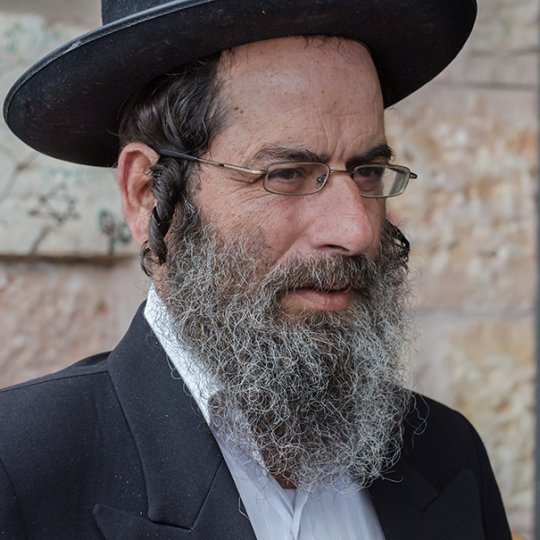
ისრაელის მოსახლეობა 8 მილიონზე მეტია 2017 წლის მონაცემებით. აქედან 2016 წლის მონაცემებით ებრაელია 74.7%, 20.8% არაბი მუსლიმი, ხოლო 2% ქრისტიანი. მთელი ისრაელის მოსახლეობის 49% თავს მიიჩნევს არარელიგიურად ანუ სეკულარულად. ანუ თავს არ მიაკუთვნებს არცერთ რელიგიას, მიუხედავად იმისა, რომ შესაძლოა სწამდეს რაიმე ზებუნებრივი ძალების, რელიგიას როგორც ინსტიტუციას არ მიიჩნევს დადებით მოვლენად (და ეს ძალიან კარგია და ახლავე გაიგებთ რატომაც). ისრაელის მოსახლეობის მხოლოდ 9% არის ჰარედი ანუ ულტრამართლმადიდებელი იუდაისტი. ამ ულტრამართლმადიდებელთა შეხედულებებს არ იზიარებს ებრაელთა უდიდესი ნაწილი, მაგრამ ფაქტია, რომ ამ ადამიანების აზროვნება ეფუძნება 26 საუკუნის წინ ჩამოყალიბებულ "ღვთის რჩეულობის" ფაშისტურ პოსტულატს. ისინი დანარჩენ ერებს მიიჩნევენ მეორეხარისხოვნად სამყაროს შემქმნელის თვალში. არაებრაელი ერები მოიხსენიებენ მათს წმინდა წიგნებში როგორც გოე ან გოემ, ეს ნიშნავს საქონელს ადამიანის ფორმით, რომელნიც მაგალითად თალმუდის მიხედვით მხოლოდ იმისთვის არიან შექმნილნი, რომ ემსახურონ მართლმორწმუნე ღვთის რჩეულ ერს - ებრაელებს. ვიმეორებ - ამ შეხედულებებს არ იზიარებს ებრაელთა უდიდესი ნაწილი, სწორედ ამიტომ და ამგვარი შეხედულებების გამო უარჰყოფს ისრაელის მოსახლეობის მოაზროვნე 49% ყოველგვარ რელიგიას და მიიჩნევს თავს სეკულარულად. ახლა კი წარმოგიდგენთ ულტრაორთოდოქსი ებრაელების საკმაოდ არასასიამოვნო გამონათვამებს, რომელთაც თავად ებრაელებიც და არცერთი მოაზროვნე ადამიანი არ ეთანხმებიან: 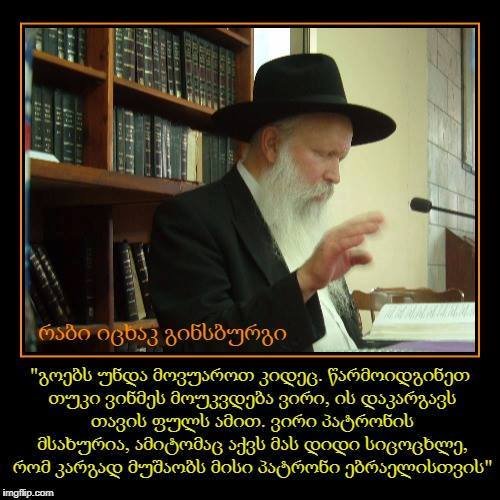
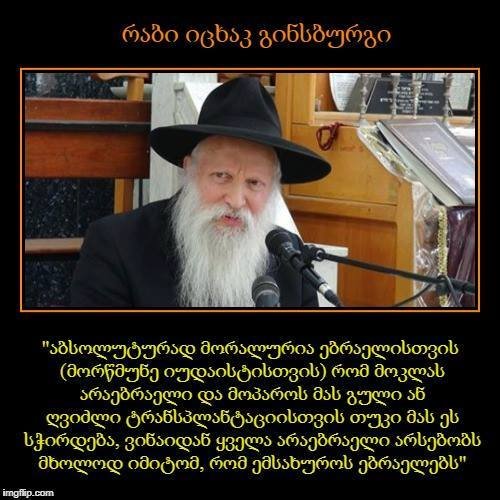
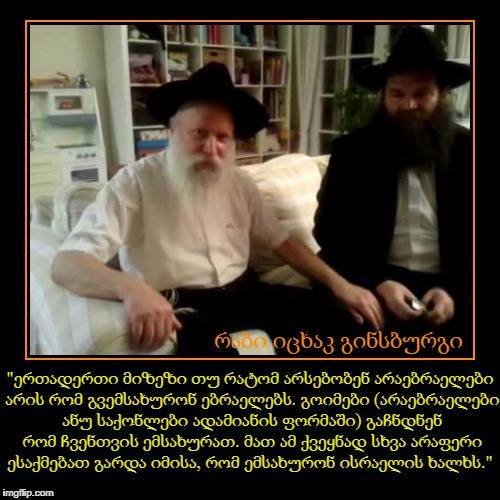
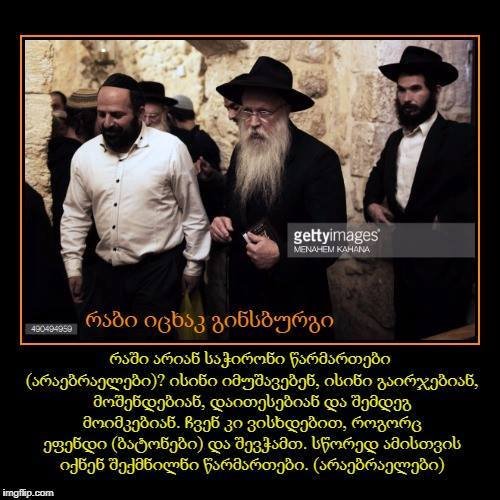
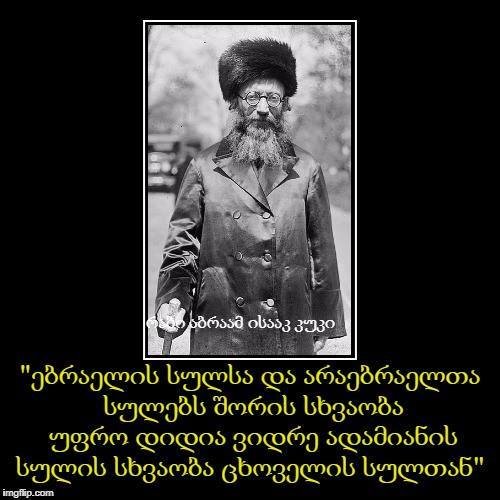
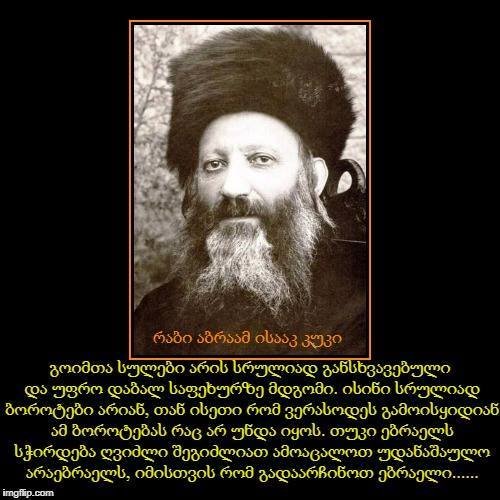
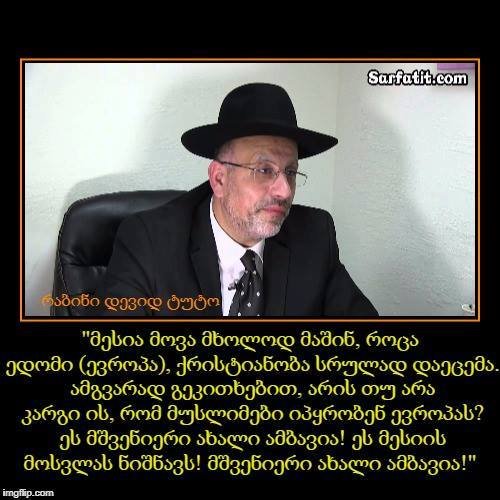
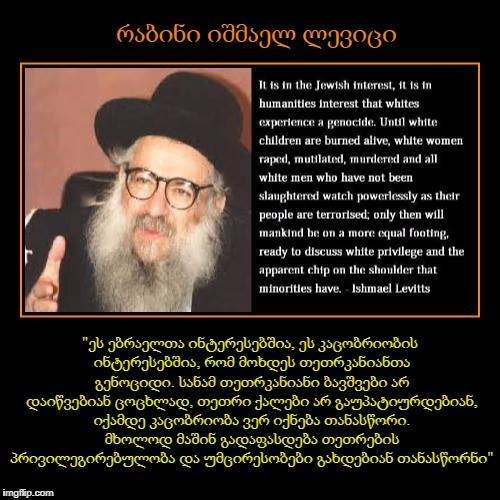
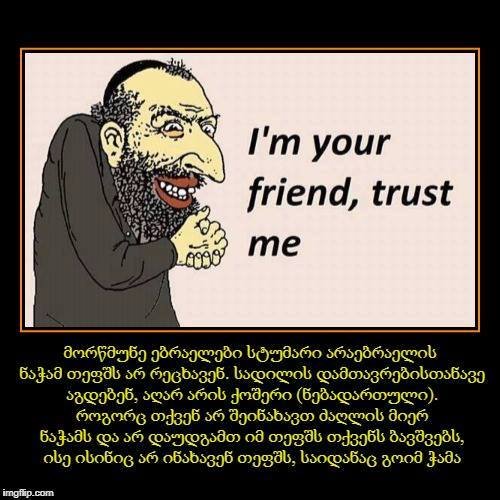
ასეთ რაბინებს სამწუხაროდ ჰყავთ თავიანთი მიმდევრები, რომელთაც ვერ შეატყობთ გარეგნობაზე რომ არიან ულტრარელიგიურები და ულტრანაციონალისტები. ისინი ზოგიერთი არიან პოლიტიკოსები ან პროფესორები უნივერსიტეტებში. და ძალიან კარგია, რომ ბევრი მათგანი აღიარებს მაინც თავის შეხედულებებს, თუმცა ცუდია, რომ ისინი ამის შემდეგ მაინც კვლავ აგრძელებნ კარიერას და არ კარგავენ სამუშაოს, ვინაიდან ეს არაფრით განსხვავდება მე-20 საუკუნის გერმანული ნაციზმისა და ფაშიზმისგან. 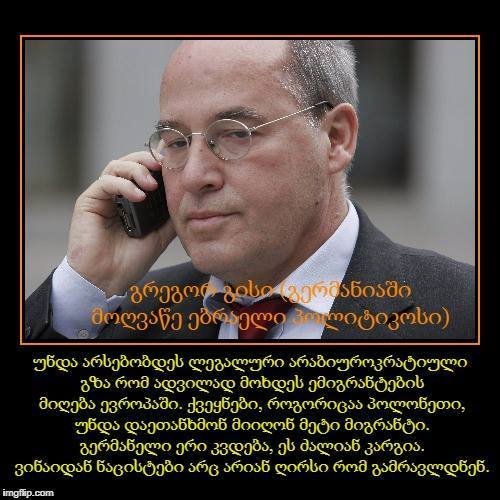
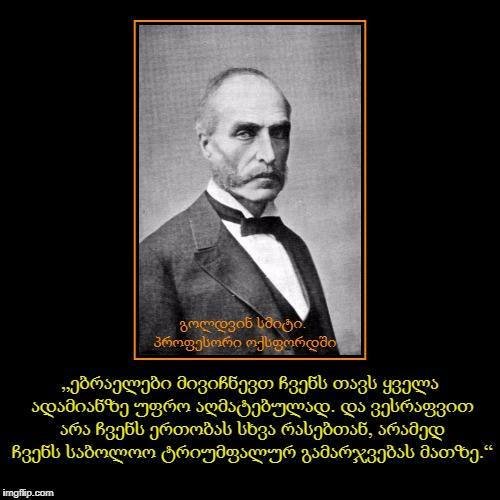
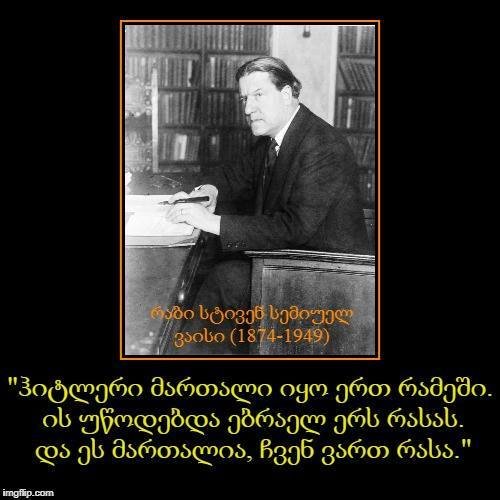
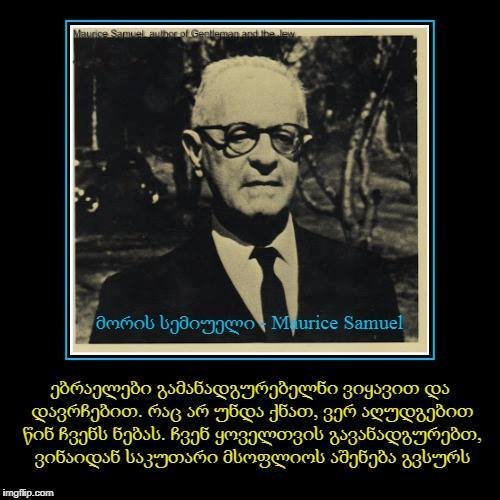
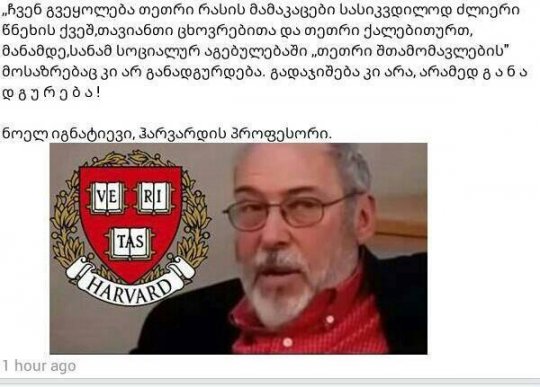
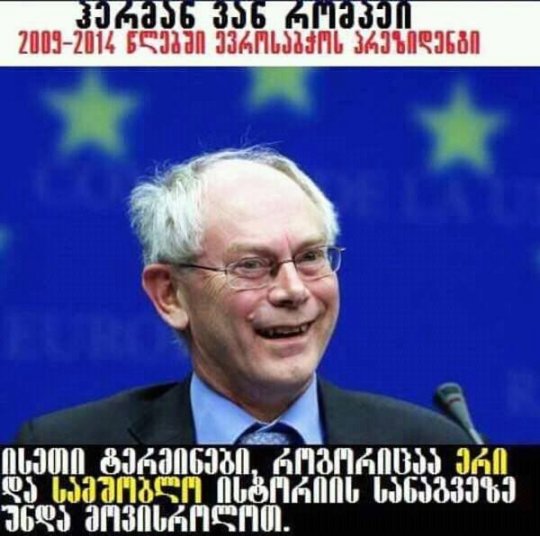
სწორედ ეს დამოკიდებულებები იცოდნენ ძველმა მოაზროვნეებმა და ამიტომ ჰქონდათ არაკეთილგანწყობილი დამოკიდებულება ებრაული თემის მიმართ, სადაც სეკულარიზაცია მხოლოდ მე-19 საუკუნეში დაიწყო. სწორედ ამ სეკულარიზაციისა და რელიგიის მარწუხებისგან გათავისუფლების შემდეგ დაიწყო ებრაელების აღმავლობა, დიდი მოაზროვნეები, დიდი მსახიობები, პოლიტიკოსები და მოღვაწეები დაბადა ებრაელმა ერმა ამის შემდგომ. ნობელის პრემიის ლაურეატთა 25%, ანუ ყოველი მეოთხე ნობელიანტი ებრაელია. ეს არის უდიდესი მიღწევა 11 მილიონიანი ერისა 7 მილიარდიან კაცობრიობაში. თუმცა ეს რელიგიური მარწუხები დღემდე ვერ გადააგდო ებრაელმა ერმა ბოლომდე და ულტრანაციონალისტების და ულტრარელიგიური ფაშისტების გამო მთელს ამ ძალიან დასაფასებელ ერს სახელი უფუჭდება. ძველ დროში, როცა მთელი ებრაული თემი იზიარებდა ასეთ განწყობებს ნახეთ ამის გამო რას ამბობდნენ მათზე ცნობილი მოაზროვნეები: 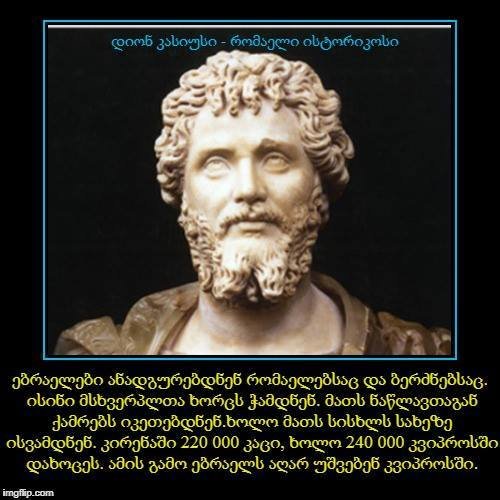
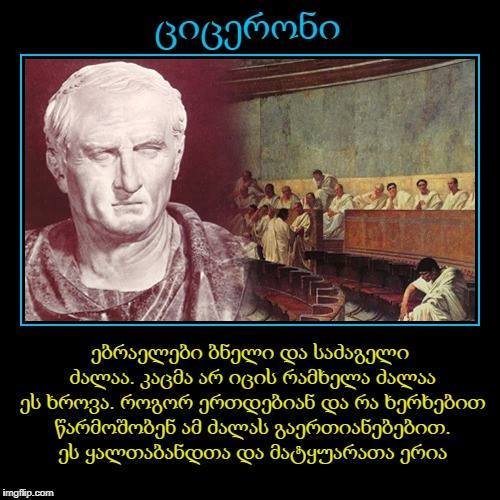
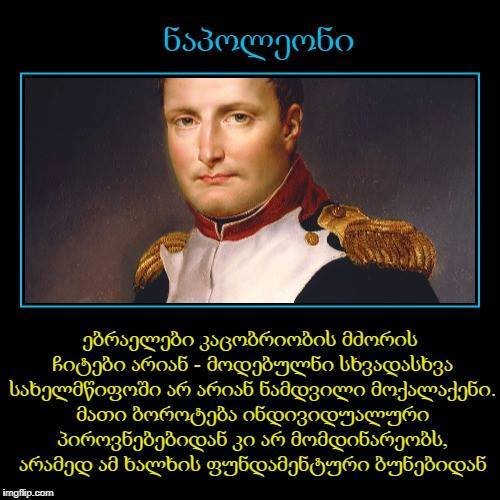
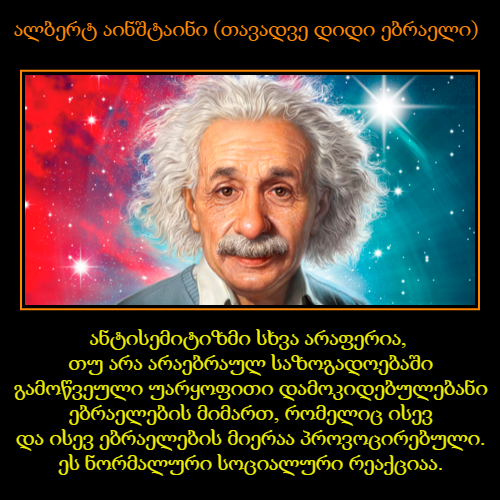
ამ სტატიით ერთადერთი რაღაცის თქმა მინდოდა: მე ხშირად ვწერ ქრისტიანობის უარყოფითი მხარეების და ისლამის ზემოთხსენებულ კვოტირებებზე კიდევ უფრო საშიშ მოწოდებებზე. ებრაელები ერთ-ერთი საუკეთესო ხალხია, ოღონდ ფანატიზმისგან და რელიგიისგან თავისუფალნი თუ არიან. სხვა შემთხვევაში... როგორც ჯონ ლენონი იტყოდა "წარმოიდგინეთ სამყარო რელიგიის გარეშე, შეიძლება მეოცნებე გეგონოთ, მაგრამ ესეც იცოდე - მე არ ვარ მარტო". ავტორი: თორნიკე ფხალაძე 1414 4-ს მოსწონს 3-ს არა |
“ვიცი, რომ მრავალი პატივს სცემს იუდეველებს და მათ ამჟამინდელ წესებს წმინდად მიიჩნევს; ამიტომ ვჩქარობ, ფესვებიანად ამოვძირკვო ეს მომაკვდინებელი აზრი … უკეთესია, ვთქვათ, რომ სინაგოგა არის მხოლოდ გარყვნილების სახლი და თეატრი, ასევე ავაზაკთა სამყოფელი და მხეცთა ბუნაგი … არა უბრალო მხეცის ბუნაგი, არამედ უწმინდური მხეცის ბუნაგი … არავინ იუდეველთაგან თაყვანს არ სცემს ღმერთს … მათ არ იციან მამა, ჯვარს აცვეს ძე, უარყვეს სულიწმინდა … იქ არ ეთაყვანებიან ღმერთს, იქ კერპთაყვანისცემის ადგილია.” - წმ. იოანე ოქროპირი [Cв. Иоанн Златоуст, Против иудеев, Слово 1, 3.].
for about 10,000 BC Proto-Afro-asiatic language split in 2 sub-groups, Hamitic (North African) and Semitic (Middle eastern) sub-groups.
Semitic language was later divided in 2 main sub-groups:
1. East Semitic (approx. 6th millennium BC.)
2. West Semitic (approx. 6th millennium BC.)
East Semitic formed Akkadian or Proto-Akkadian language. later this language formed Old Akkadian language. It was named after the city of Akkad and first appeared in Sumerian texts dating from 2,800 BC in the form of Akkadian names. Old Akkadian language formed Babylonian (17th century BC.) and Assyrian languages (10th century BC.). they were dead for 500 AD. So, East Semitic sub-group now is dead.
West Semitic language sub-group later formed 5 groups of languages:
1) Ethiopic languages (approx. 5th millennium BC)
2) Old Arabian languages (approx. 10th century BC)
3) Modern South Arabian languages (approx. 2nd millennium BC)
4) Central Semitic (approx. 5th millennium BC)
Central Semitic and West Semitic both formed Arabic language in approx. 2300-2000 BC.
Arabic language formed
Modern Arabic dialects (approx. from the 1'st century AD.
and Maltese (Approx. 8th century BC.).
Central Semitic language then formed Northwest Semitic language (6th-5th Millennium BC).
Northwest Semitic language formed Amorite language (2100 BC)
Amonite language formed Ugaritic language (approx. 1600-1150 BC)
Amonite language formed Canaanite languages (1500 BC)
Cannanite languages formed Aramaic language (1150 BC) and Hebrew language (1150 BC).
1150–950 BC Formation of Jews, Hebrews - Israelites
Canaan in the Late Bronze Age was a shadow of what it had been centuries earlier: many cities were abandoned, others shrank in size, and the total settled population was probably not much more than a hundred thousand. Settlement was concentrated in cities along the coastal plain and along major communication routes; the central and northern hill country which would later become the biblical kingdom of Israel was only sparsely inhabited although letters from the Egyptian archives indicate, that Jerusalem was a Canaanite city-state recognizing Egyptian overlordship. Politically and culturally it was dominated by Egypt, each city under its own ruler, constantly at odds with its neighbors, and appealing to the Egyptians to adjudicate their differences.
The Canaanite city state system broke down during the Late Bronze Age collapse and Canaanite culture was then gradually absorbed into that of the Philistines, Phoenicians and Proto-Israelites. The process was gradual and a strong Egyptian presence continued into the 12th century BC, and, while some Canaanite cities were destroyed, others continued to exist in Iron Age I (1150–950 BC.).
Archaeologist Paula McNutt says: "It is probably during Iron Age I, that a population began to identify itself as 'Israelite'," differentiating itself from its neighbors via prohibitions on intermarriage, an emphasis on family history and genealogy, and religion.
In the Late Bronze Age there were no more than about 25 villages in the highlands, but this increased to over 300 by the end of Iron Age I (950 BC), while the settled population doubled from 20,000 to 40,000. The villages were more numerous and larger in the north, and probably shared the highlands with pastoral nomads, who left no remains. Archaeologists and historians attempting to trace the origins of these villagers have found it impossible to identify any distinctive features that could define them as specifically Israelite – collared-rim jars and four-room houses have been identified outside the highlands and thus cannot be used to distinguish Israelite sites, and while the pottery of the highland villages is far more limited than that of lowland Canaanite sites, it develops typologically out of Canaanite pottery that came before. Israel Finkelstein proposed that the oval or circular layout that distinguishes some of the earliest highland sites, and the notable absence of pig bones from hill sites, could be taken as markers of ethnicity, but others have cautioned, that these can be a "common-sense" adaptation to highland life and not necessarily revelatory of origins. Other Aramaean sites also demonstrate a contemporary absence of pig remains at that time, unlike earlier Canaanite and later Philistine excavations.
In The Bible Unearthed (2001), Finkelstein and Silberman summarised recent studies. They described how, up until 1967, the Israelite heartland in the highlands of western Palestine was virtually an archaeological terra incognita. Since then, intensive surveys have examined the traditional territories of the tribes of Judah, Benjamin, Ephraim, and Manasseh.
These surveys revolutionized the study of early Israel. The discovery of the remains of a dense network of highland villages – all apparently established within the span of few generations – indicated that a dramatic social transformation had taken place in the central hill country of Canaan around 1200 BC. There was no sign of violent invasion or even the infiltration of a clearly defined ethnic group. Instead, it seemed to be a revolution in lifestyle. In the formerly sparsely populated highlands from the Judean hills in the south to the hills of Samaria in the north, far from the Canaanite cities that were in the process of collapse and disintegration, about two-hundred fifty hilltop communities suddenly sprang up. Here were the first Israelites.
Modern scholars therefore see Israel arising peacefully and internally from existing people in the highlands of Canaan.
Scholars doubt that the Canaanites were ever politically united into a single kingdom. In fact, archaeological excavations indicate that the "Canaanites" were actually made up of different ethnic groups. During the Late Bronze Age (1550-1200 B.C.), "Canaan was not made up of a single 'ethnic' group but consisted of a population whose diversity may be hinted at by the great variety of burial customs and cultic structures" wrote Ann Killebrew, an archaeology professor at Penn State University, in her book "Biblical Peoples and Ethnicity" (Society of Biblical Literature, 2005).
Early Northwest Semitic (ENWS) materials are attested through the end of the Bronze Age - 2350 to 1200 BC. At this early state, Biblical Hebrew was not differentiated from the other Northwest Semitic languages (Ugaritic and Amarna Canaanite), though noticeable differentiation did occur and Hebrew as a separate language developed during the Palestinian Iron Age I (1150–950 BC), between the Jordan River and the Mediterranean Sea, an area known as Canaan.
Northwest Semitic, known as Syro-Palestinian in dialect geography, is a division of the Semitic languages comprising the indigenous languages of the Levant. It would have emerged from Common Semitic in the Early Bronze Age (approx. 3000-2400 BC) It is first attested in proper names identified as Amorite in the Middle Bronze Age (approx. 2000 BC). The oldest coherent texts are in Ugaritic cuneiform, dating to the Late Bronze Age (1300-1200 BC), which by the time of the Bronze Age collapse are joined by Old Aramaic, and by the Iron Age (1150–950 BC) by the Canaanite languages (Phoenician and Hebrew).
Northwest Semitic, known as Syro-Palestinian languages:
Aramaic
Canaanite
Amorite (extinct)
Samalian (extinct)
„ისლამი აუცილებლად უნდა იყოს ევროპის აწმყოში და მომავალში“ - ფედერიკა მოგერინი, ევროკავშირის წარმომადგენელი საგარეო საქმეებში, პოლიციის თავჯდომარე და იტალიის "სოციალ-დემოკრატიული პარტიის" წევრი (გახლდათ "იტალიის კომუნისტური ახალგაზრდობის ფედერაციის" წევრი, შეუერთდა "ახალგაზრდულ მემარცხენე ფრთას", "იტალიის კომუნისტური პარტიის" დაშლისა და მისი "სოციალ-დემოკრატიულ პარტიად" გარდასახვის შემდეგ).
„ჩემთვის, გერმანიის არსებობა მხოლოდ იმიტომაა მისაღები, რომ ისრაელის და ებრაელი ხალხის კეთილდღეობას უწყობს ხელს“ - მარტინ შულცი, ევროკავშირის პარალამენტის პრეზიდენტი.
„არ იქნება არცერთი ევროპული სახელმწიფო, რომელიც მულტიკულტურალიზმს არ მიიღებს“ - ფრანს ტიმერმანი, ევროპული კომისიის ვიცე პრეზიდენტი.
„ჩვენ ისე უნდა ვიმოქმედოთ, რომ რასისტული განცხადებების გაკეთება, კანონით უმკაცრესად ისჯებოდეს“ - ვიაჩესლავ მოშე კანტორი, ებრაელთა ევროპული კავშირის და ევროკავშირის პრეზიდენტი ტოლერანტობის შესახებ.
სატანურ ძალას, რომელიც ევროკავშირის სახელით მართავს ევროპას, აქვს მხოლოდ ერთი მიზანი: გაანადგუროს ევროპული ცივილიზაცია და ევროპელები. ბოლო ხანებში საქართველოშიც შესამჩნევად გაიზარდა (((ევროკავშირის))) პროპაგანდა, თანაც სკოლებში. (((ისინი))) და მათი დამქაშები, ძირითად შემთხვევაში, სამოქალაქოს მასწავლებლები, რომლებმაც ფულზე გაყიდეს, სამშობლო და საკუთარი ხალხი, ტვინს უპროგრამებენ ახალგაზრდა თაობას. დაიმახსოვრეთ ყველა მასეთი მოღალატის სახელი და გვარი, დრო მოვა უმკაცრესად მოუწევთ ქვეყნის ღალატზე პასუხისგება. "
ნამდვილად აღსანიშნავია რომ, მართლაც არცერთ ერს ამ ხალხთან კავშირი არ აქვს, გარდა იმისა რომ ყველა ერმა შეიფარა და მადლობის ნიშნად ყველგან მდაბიო საქციელი იკადრეს.
არა მხოლოდ კანტი, ბევრი მოაზროვნე თუ „დაუდაღავი“ პოლიტიკოსი თვლიდა რომ „ებრაელები“ ცუდი ხალხია, მაგრამ მე მაინც ვფიქრობ რომ მათში არის რაღაც ძველი ქართული, კერძოდ მესხური – ამიტომ ვფიქრობ შეიძლება მათში ძველი ფესვის დაბრუნება და იუდეური ბურუსიდან განთავისუფლება.
ყველა ქვეყანა ყოველთვის ცდილობს, ყველგან სათავისოდ იმოქმედოს. აქედან გამომდინარე მეც მიმაჩნია რომ „ებრაელებში“ ღირს სასაქართველისოდ მოქმედება.